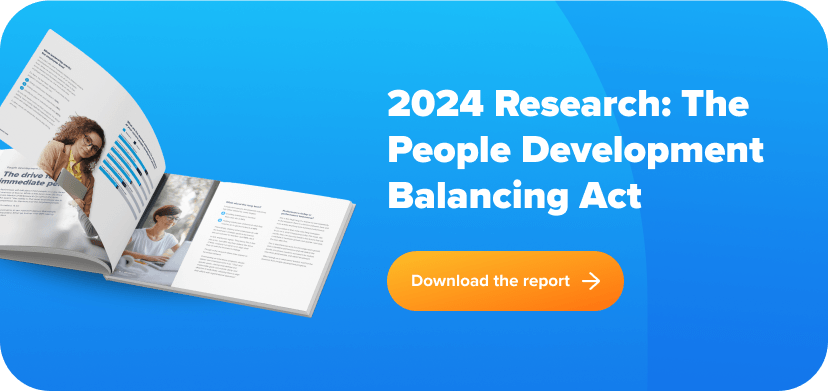These days, companies often shift from the reflective performance management model to check-in performance management model, focusing on the employee rather than the organisation.
My hands-on experience comes from multiple implementations and dialogues with mainly HR executives in mid-sized and large organisations. These investigations clearly indicate how you can run performance management more efficiently by using the appropriate model. This may be valuable to you if you wonder which performance management model will work in your organisation, why that is so and how you make it work.

The Reflective Performance Management Model
Let me start with what I call “Performance Management From the Past”. It’s broadly characterized by the yearly performance review or appraisal and is popular among roughly a third of corporate organisations. Per the reflective performance management model, the employee and the manager evaluate the employee’s performance and potential once per year, as well as pinpoint which areas to focus on in the year ahead.
This leads to elements such as compensation incentives and career opportunities in the company. Over the last few years, we have seen more and more companies move away from the reflective performance management model. One of the problems with this practice is that it fails to create real value and is incredibly time-consuming, thus costing too much in resources and non-effective work time.
If you ignore the time-consuming aspect, reflecting on the year that has passed and the year to come can be beneficial. The benefits of the reflective performance management model include the reflection exercise itself with a thorough focus on review and feedback. However, the disadvantages are all too overwhelming as there is too much time between each reflection exercise, as well as placing the employee in a fixed box. The fact is that output is almost non-existent, as it is often done on paper or in very complex systems, ending up tucked away in a drawer or a remote folder without real follow-up.
It’s too early to declare the reflective performance management model to be dead. Many companies use it, even though they actually want to find an alternative, either because it is hard to find or because their HR department maintains a focus on the task itself rather than on the desired output and process of getting there.
The Check-in Performance Management Model
The second model, the check-in performance management model, focuses on the individual employee, rather than what the company thinks it needs, in order to drive performance improvement. Basically, in the check-in performance management model, you start with putting your attention on these five development areas:
- Move the employee and manager impact and by that their performance
- Move the employee and manager aligning them to your values and culture
- Move the employee by giving feedback and help managers do best-in-class leadership
- Move employee motivation upward and close down the employee churn
- Move employees and managers by providing a simple and user-friendly tool to revive performance management
In the check-in performance management model, which I believe is the better approach for organisations today, commitment and output will differ completely from the reflective model. You simply change your approach by putting the employee and manager at the heart of a good experience. Basically, you skip the annual review and instead you focus on everything in between. This increases the focus on the individual, as you have an ongoing attention to the well-being, feedback, and development that is relevant and important to the individual. In addition, it puts the managers in a situation where evaluation is continuously ensured, thereby reassuring the employee that attention is paid to them.
This Check-in Performance Model is adopted by many of the best performing organisations today. By breaking down the annual review process into quarters, months or weeks, depending on the type of your organisation, you focus exclusively on the areas that are relevant now and not all areas at one time. Your development awareness needs to be on competencies, skills, and processes rather than on hard KPIs. That’s what moves people and changes outcomes.
Making Your Performance Management Model Work
Today, many performance management solutions focus on both the models described above providing effective results. You do not always have to choose one over the other, or get stuck in a very non-user-friendly solution. Here’s an overview of the different solutions you can apply:
Yearly Review
The Yearly Review is still a nice way of doing performance management if you prefer a top-down approach, the reflection model and placing individuals in development grids. At eloomi, we’ve been working with several companies around this topic. This year we launched an up-to-date tool that gives middle management a chance to reduce time consumption from 5 weeks to 5 hours. And giving the employees a much more motivational approach to the conversation, assigning the manager and employees the objective(s) to work on, as well as integrating relevant training plans.
As a bonus, it is done digitally on any kind of device and can be changed from yearly intervals into quarters or other intervals. This gives you a much more aligned approach maintaining a focus on the reflective practice.
Goals and Objectives
Goals and Objectives are the new way of checking in. In this exercise, you simply specify goals and objectives as an outcome of your 1-1s and performance review conversations.
If necessary, an objective will be opened with ongoing check-ins on progress and OKRs. Goals and Objectives help managers to focus on what is important for the job role, as well as each individual’s personal development plan. Plus, eloomi gives the manager an easy access to give feedback and an opportunity to focus on continuous development.
This easy way to drive performance management is extremely effective. Great for activity-focused organisations that prefer to measure developments.
Check-lists
Checklists are the out-of-the-box solution for companies that want a very easy follow up process. Make company specific task lists, with check marks if they are agreed upon. This is a good tool for retail companies or production companies, where the value of applying performance management lies more in the achievement of requirements than on a continuous development plan.
The Winning Performance Management Model
There are a million ways to go about performance management, and it’s easy to feel overwhelmed. The good news is that it’s easy to combine aspects from the different performance management models and take the best from all of the solutions. But remember that all companies are different and you have to take this into account when talking about performance management. And within each company, no two employees are motivated by the same solutions.
This is one of the most significant reasons why most performance management solutions fail. Simply because they don’t adjust to the differences in cultures and motivational factors within organisations and groups of employees.
Nothing good can come from forcing a specific performance management solution onto your organisation, as it will have little effect. The winning performance management model is thus to look at your own organisation, and choose the performance management models best suited. Perhaps Sales Managers need management through Checklists as they are highly action driven, while other departments are motivated by dialogue with Goals and Objectives being a better choice. It’s a question of finding the right balance giving you the absolute best outcome in your organisation.
The most effective approach to performance management is a combination of multiple solutions in one frame, focusing on the employee rather than the solution. Take a starting point in the employee and manager and ensure a flexible toolbox to enable the best possible insight into how you perform HR of the future.







